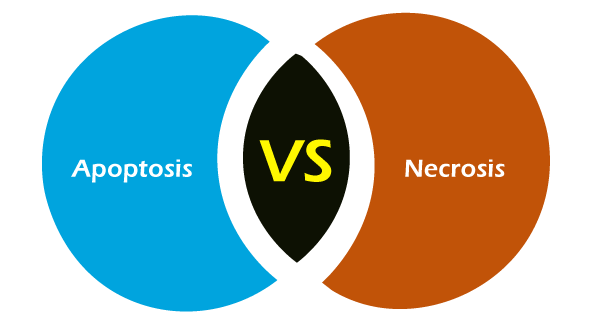Difference between Apoptosis and Necrosis

Apoptosis and necrosis are both processes of cell death, but they differ in their mechanisms, characteristics, and roles in biological systems. Here are the key differences between apoptosis and necrosis:
-
Mechanism:
- Apoptosis: Apoptosis, also known as programmed cell death, is a controlled and regulated process that occurs in response to various physiological cues or signals. It involves a series of biochemical events that lead to cell shrinkage, chromatin condensation, DNA fragmentation, and the formation of apoptotic bodies, which are subsequently engulfed and cleared by neighboring cells or phagocytes.
- Necrosis: Necrosis is an uncontrolled and chaotic process of cell death that occurs as a result of cellular injury, trauma, or pathogenic processes. It typically involves cell swelling, rupture of the plasma membrane, release of cellular contents into the extracellular space, and inflammation. Necrosis is often associated with tissue damage and inflammation.
-
Regulation:
- Apoptosis: Apoptosis is tightly regulated by a complex network of signaling pathways and regulatory molecules, including pro-apoptotic and anti-apoptotic proteins. It plays a critical role in various physiological processes, such as embryonic development, tissue homeostasis, immune system regulation, and elimination of damaged or unwanted cells.
- Necrosis: Necrosis is not a regulated process and does not involve specific signaling pathways. It occurs in response to severe cellular damage or stress and is often considered a pathological or pathological response. Necrosis is typically associated with acute injury, ischemia, infection, and other forms of cellular trauma.
-
Cellular Morphology:
- Apoptosis: Apoptotic cells exhibit characteristic morphological changes, including cell shrinkage, chromatin condensation, nuclear fragmentation, and the formation of membrane-bound apoptotic bodies. These apoptotic bodies are subsequently engulfed and phagocytosed by neighboring cells or phagocytes without eliciting an inflammatory response.
- Necrosis: Necrotic cells display different morphological features, such as cell swelling, cytoplasmic vacuolization, organelle disintegration, plasma membrane rupture, and release of cellular contents into the extracellular space. Necrosis is often associated with inflammation and tissue damage due to the release of inflammatory mediators and damage-associated molecular patterns (DAMPs).
-
Inflammation:
- Apoptosis: Apoptosis generally does not trigger inflammation because apoptotic cells are rapidly cleared by neighboring cells or phagocytes in a silent and non-inflammatory manner. In fact, apoptosis may help to suppress inflammation by preventing the release of pro-inflammatory intracellular contents.
- Necrosis: Necrosis often induces inflammation due to the release of pro-inflammatory cytokines, chemokines, and DAMPs from damaged or ruptured cells. Inflammatory cells are recruited to the site of necrosis, leading to tissue inflammation, immune responses, and potential tissue damage.
In summary, apoptosis and necrosis represent distinct modes of cell death with different mechanisms, regulation, morphological characteristics, and implications for tissue homeostasis and pathology. Apoptosis is a regulated and controlled process essential for normal development and tissue turnover, whereas necrosis is an uncontrolled and pathological process associated with tissue damage, inflammation, and disease.
Thank you,
